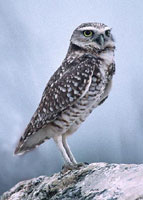|

Status: In the late 1970s there were about 2,100 breeding pairs left in Canada. By 1987, the population had dropped by half,
with 700 pairs remaining in Alberta. After continued decline, burrowing owl status was upgraded from threatened to endangered
this year.
Behaviour: Burrowing owls only spend the summer in Alberta. It's not known exactly where they winter, but they probably
migrate to the south-western United States or Mexico. Unlike most owls, these ones live in burrows in the ground, are active
during the day and prefer to eat insects. In some populations, breeding pairs live close together in colonies. They take over
and modify abandoned burrows of badgers, gophers or foxes.
Appearance: Burrowing owls look like short, fat owls on stilts. They often stand upright on long, thin legs to see farther
over the prairie.
Food: Mainly insects, some rodents, toads, small birds, dead animals.
Breeding: Courtship displays include flashing white markings, cooing, bowing, scratching, nipping and repeated short flights.
The male prepares the burrow by lining it with dried plants, feathers and cow dung. The female then lays 6-12 eggs and stays
underground to incubate them for about four weeks. The young birds begin to hunt for themselves after seven to eight weeks.
Risk factors: Cultivation and development have significantly reduced the owls' habitat. Burrowing owls require open areas
with low ground cover, existing burrows and abundant food -- all of which are threatened on the prairies. Owls rely entirely
on burrowing animals for their nests, and many of these animals are exterminated as pests. Burrowing owls have also been killed
accidentally as a result of poison programs aimed at pests and insects.
Management and Outlook: Alberta Environmental Protection's wildlife management division aims to increase the burrowing
owl population to 1,000 breeding pairs. Through Operation Burrowing Owl, farmers have agreed not to cultivate more than 50,000
acres of grassland in known owl habitats. Careful livestock management will also increase the amount of food available for
owl pairs and the number of young they produce. In the four western provinces, it is illegal to kill or disturb burrowing
owls or their nests.
Researched by wishintreeUK (Katie)
Back to Endangered Animals
|



